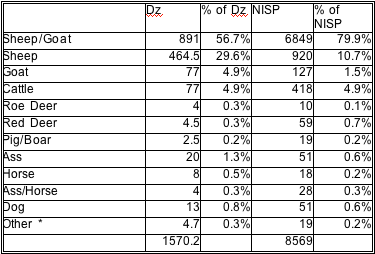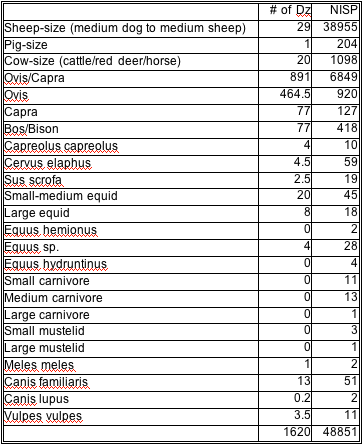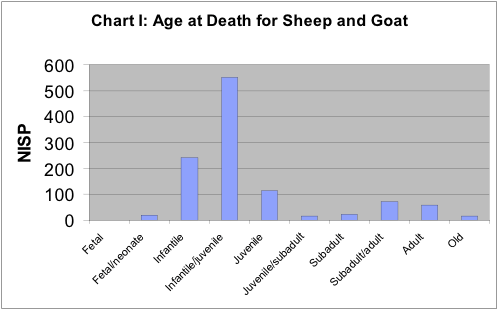ÇATALHÖYÜK 2004 ARCHIVE REPORT
| |
STUDY SEASON REPORTS
West Mound
Catriona Gibson and Jonathan Last with contributions by Sheelagh Frame and Tiffany Raszick
Abstract
Following the final season of excavation in 2003 (2003 Archive Reports), the West Mound Project team undertook a study season comprising analysis of Chalcolithic ceramics (by C. Gibson and J. Last), animal bone (by S. Frame) and lithics (by T. Raszick), all of which are reported here. Additional work was undertaken on the groundstone (by A. Baysal), botanical remains (by M. Charles and A. Bogaard), heavy residue (S. Mitrovic), human remains (S. Bello) and Roman/Byzantine ceramics (L. Zoroglu and C. Toskay Evrin). M. Roughley (Wessex Archaeology) joined the team this year as illustrator, and drew pottery, lithics and other artefacts in preparation for the forthcoming publication.
This report briefly describes the work undertaken on site by the main West Mound Project specialists. Further analysis of the recorded material will take place during 2004-5 with the aim of producing a draft text by summer 2005. Reports from the other specialists are not included here but will be integrated into the draft volume during the coming year.
Özet
2003'deki son kazı çalışmalarının tamamlanmasından sonra (bkz. 2003 Arşiv Raporu), Batı Tepesi Projesi ekibi, yanlızca, çıkarılan arkeolojik malzeme üzerine çalışmak için bir sezon başlatmış ve Kalkolitik çanak-çömlek (C.Gibson ve J.Last), hayvan kemiği (S.Frame)ve taş (T. Raszick) malzeme üzerine yapılan çalışmalar bu sezonda gerçekleştirilmiştir. Buna ek olarak sürtme taşları (A.Baysal), bitki kalıntıları (M. Charles ve A.Bogaard), yüzdürme (flotation) örnekleri (S.Mitrovic), insan kalıntıları (S.Bello) ve Roma/Bizans çanak-çömlekleri (L.Zoroglu ve C.Toskay Evrin). M.Roughley (Wessex Arkeoloji Ünitesi) bu yılki çalışmalara çizimci olarak katılmış ve çanak-çömlek, taş ve diğer buluntuların gelecek yayının hazırlığı için çizimlerini yapmıştır.
Bu rapor Batı Tepesi Projesi uzmanlarının çalışmalarının genel çerçevesini ortaya koymaktadır. Kaydı yapılmış olan diğer malzemenin daha ayrıntılı çalışmaları 2004/2005 yılında yapılacak olup, amacı 2005 yılı için bir taslak çıkarmak olacaktır. Diğer uzmanların raporları burada yer almayacak ancak gelecek yıl çıkarılacak olan taslağa dahil edilecektir.
Chalcolithic Pottery by Catriona Gibson (1) & Jonathan Last (2)
1. Wessex Archaeology. 2 English Heritage
A total of 4500 pottery sherds were analysed in detail this season, and all diagnostic and decorated sherds from secure contexts have now been fully analysed. In addition, at least 50% of all undecorated body sherds from secure contexts have been analysed.
The pottery has been recorded on pro forma sheets and is being entered into a computerised database. Overall sherd counts and pottery weights were recorded for all units. Beyond that a three-level recording system has been adhered to, as described in the 2002 archive report. That report also outlines the main research questions that we are seeking to answer. In addition, the analysis aims to provide data comparable with other categories of material, such as lithics and animal bone, in order to discern depositional patterns across the different spaces of B.25.
We are beginning to identify a number of differences within the nature of the assemblages from the various spaces, particularly with respect to discard processes. In conjunction with the other specialists, we are using the pottery, animal bone and lithics to help identify the various formation processes associated with the different spaces and whether particular signatures can be identified.
One of the most striking results of the 2003 excavations was the recognition of large dumps or clusters of pottery and other artefacts within the small western spaces of Building 25. Recording of these assemblages suggests that they differ from the clusters found higher up in the fills of Building 25 which were interpreted as closure deposits, and included particularly fine and freshly broken vessels with a large number of joins across contexts (described in the 2000 archive report). The concentrated dumps of material from the lower spaces of Building 25 were of a different nature and included a mixture of both fine and coarse vessels in a variety of conditions (Figs. 101a & 101b). Much of the pottery from these lower dumps was sooty and/or abraded, which may be more indicative of midden-like dumps, especially given an association with very fragmented animal bone in certain contexts.
 |
 |
Figure101. Two large jar rims from unit ( 9025), (a) unabraded. (b) with abrasion on neck and shoulder
Chipped Stone - Tiffany Raszick
University of Liverpool
What follows is a short report on the final study season of the West Mound chipped stone assemblage. The main objectives of this year were to: 1) complete the data collection and to 2) come to some preliminary understanding of the technological industries working at Çatalhöyük West in the Early Chalcolithic period.
By the end of the study season all chipped stone objects, debris and tools alike, were recorded at the primary level of analysis. That is, total counts and basic categorisation of the artefacts within each unit, and their weights, have been recorded for all units excavated. All ‘X-finds' (those finds deemed significant in the field) have had their attributes recorded in detail. Finally, the attributes (detailed analysis) of all objects from secure Chalcolithic units were recorded.
Three main chipped stone industries appear to have been undertaken at the West Mound in the Early Chalcolithic period. Within these, there is some variation in technique. Those that have to date been identified are as follows:
Percussion: there is evidence of some core initiation and rejuvenation within this industry. Most likely, production of these artefacts was occurring at the site, with the exception perhaps of the large blades (see below).
Symmetrical-to-asymmetrical blade production: these blades are less regular in form than the pressure blades (described below).
Large, wide blade production: The first impression is that these objects are manufactured off-site, given the general lack of large cores. However, this may be an in-house industry because a substantial core of a rare (identified by sight, not confirmed analytically as yet) obsidian type from which one of these large blades was identified, has been found in the assemblage.
Pressure: there is little evidence for core initiation at the site indicating that perhaps the cores are arriving on site in a prepared form. There is evidence for core rejuvenation and reduction, which shows that at least some of the people at the West Mound had the ability to pressure flake as well as using the percussion technique.
Regular blade production: these blades have parallel ridges and edges, with small flat or removed platforms. There is a greater amount of core preparation for these blade removals than in the percussion flaking.
Large, wide blade production: this is possibly occurring off-site; no cores belong to this technology have been identified in the assemblage.
Bipolar: blades produced from opposed platform cores are not large in number, making up only about 3% of the blades in the assemblage. There are associated cores in the collection of artefacts but what their small numbers means is unclear at the moment.
While a number of flakes have been identified within the chipped stone assemblage, further analysis is required in order to determine the character of any specific flake industry. It also needs to be determined if or to what extent flake removals were part of core preparation and blade production.
Another of the interesting tasks to be completed in the near future is the comparison of the chipped stone assemblage within and between contexts. This and a detailed discussion of the lithic technology are forthcoming. For other preliminary comments on the West Mound chipped stone assemblage, please refer to the 2003 archive report located at the Catalhoyuk website.
Animal Bone - Sheelagh Frame
The data collection stage of the animal bone research is now concluded, and approximately 50% of the bone excavated from the West Mound has been examined. Much of the unexamined bone is from topsoil, Classical graves, or contexts that are otherwise considered contaminated. In total the faunal database has entries for 130 contexts, 121 of which have been completely recorded. The remaining nine had either bird bones or bone tools that were pulled for analysis by other specialists, but were not otherwise studied. The contexts studied represent the full range of context types and are spatially distributed throughout Building 25. Since external spaces were not examined in large areas, middens remain under-represented in the excavation sample, potentially biasing the animal bone assemblage.
In total 85,212 pieces of bone were recorded, of which 8,569 (10%) could be identified to genus. Most of these can in fact be identified to species except for the large percentage that are either sheep or goat. No new mammals were identified this season and the list of species present in the assemblage remains the same (Table 55). Sheep and goat make up an astonishing 92% of the assemblage (Table 54). While it is normal for these two species to dominate Chalcolithic assemblages in Anatolia, the extremely high number does suggest some sampling bias. The ratio of sheep to goat is 7:1(NISP) or 6:1 (diagnostic zones) which is within the normal range for a Late Neolithic/Chalcolithic assemblage. The only other mammalian species that seems to have made a significant contribution to the diet is cattle, which makes up just under 5% of the assemblage.

*Other - fox, wolf, badger, small mustelid
Table 54: Relative Proportion of Common Taxa –

Table 55: Taxa Identified
Ongoing research is focused on two broadly defined and overlapping areas: 1) the economic aspects of the animal management strategies of the Chalcolithic inhabitants of Çatalhöyük and 2) the cultural practices that illuminate the human/animal relationships at this site. The first question will include clarifying the domestic status of the species in the assemblage. This was discussed in last year's archive report and will be fully analyzed in the coming year. Another aspect of herd management is slaughtering practices. One of the striking features of the Chalcolithic assemblage is the large number of fragile infantile specimens (Chart 1). This may be partly due to the excellent preservation conditions, but may also reflect a new production strategy, with a stronger emphasis on dairy production. This needs to be explored along with other issues such as mobility and butchering practices which have also been briefly discussed in previous archive reports.
This year's work has also confirmed the pattern of specialized deposits of selected parts of sheep and goat in some contexts. These cultural uses of animals are completely different from those seen on the East Mound and yet show the continuing importance of animals in the cultural life of the West Mound society. Untangling and interpreting these patterns and integrating them with the other archaeological data will be an important part of this research.

Roman/Byzantine Human Remains by Jonathan Last & Silvia Bello
Remains of 11 individuals from the Late Roman/Byzantine graves were rapidly assessed. Five were found complete or nearly complete and articulated, one was found partially articulated but severely truncated and the rest were disturbed and disarticulated.
Skeleton (3450) Grave (3441)
The grave was capped with decorated tiles and the position of the skeleton suggests it had been buried within a coffin. In terms of pathologies, the skeleton, which was an adult male, possibly in his 50s, was one of the most interesting found at the site. There was ossification of many ligaments, and arthritis in the patellae and elsewhere. The vertebrae were compressed and/or fused (i.e. there was curvature to the spine). There was no articulation of the left shoulder and humerus, and thus he would have had no movement in his left arm since childhood, causing the bones of the arm to atrophy through disuse. The bones showed considerable ossification, but were very light and prone to fractures (e.g. of several ribs). It seems likely that he had suffered from both polio and a general infection or metabolic disease. He would probably have needed care throughout his life.
Skeleton (3473) Grave F.700
The grave was large and lined with a large number of blocks of unworked limestone. The skeleton, which was accompanied by a worked bone distaff and a signet ring, was probably an adult female, without many pathologies but with arthritis in the right patella. The skull was notable for having a prominent occipital bun.
Skeleton (3497) Grave F.705
Only part of this skeleton was preserved, and all the bones were disarticulated. It appears to be a sub-adult of about 15-18 years of age.
Skeleton (6516) Grave F.709
Like (3450), skeleton (6516) showed signs of a coffin burial, and like F.700, the grave was lined with limestone blocks, though this one was smaller and less elaborate. The skeleton was a young adult male aged about 25 years, with some peristitis in both tibiae and fibulae but no arthritis. Only a small part of the skull (left parietal) was preserved. An interesting feature of this skeleton was that both legs and the teeth had been exposed to sun and weather.
Skeleton (7226) Grave F.726
This grave was particularly elaborate. The sides and base were made from tiles, with traces of plastering and painted decoration, and the grave was capped with two massive slabs of limestone. The skeleton was a mature adult male of around 40 years of age, and was generally healthy. Like (6516), there were signs of temperature effects on some bones.
Units (7283/7296/7715/7719) Grave F.730
Disarticulated bones from a disturbed grave represent a sub-adult male of about 15-17 years of age.
Units (7285/7287/7289/7292/7707/7713) Grave F.732
Disarticulated bones from another disturbed grave, adjacent to F.730, represent an adult, probably over 60 years of age and lacking teeth, with a partial spina bifida, and probably some arthritis.
Skeleton (7706) Grave F.731
Again the human remains were disarticulated and disturbed, but the tile-lined base of the grave survived. Parts of a sub-adult, less than 15 years of age and possibly male, were represented by skeleton (7706).
Skeleton (7744) Grave F.735
This grave was constructed from orange mud-bricks. It contained skeleton (7744), which was a young adult of around 20-25 years of age, and probably male. He had pathological features (pitting) on several bones, including the lumbar vertebrae and both femurs. These are symptoms of brucellosis, a disease which may be contracted from cattle (e.g. from drinking contaminated milk). This disease may well have been the cause of death.
Units (7796/7745) Grave F.749
Some pieces of this individual were recovered from fill (7745) of pit F.747, which had truncated the grave. Only the torso and mandible of the skeleton survived articulated. The skeleton could be an adult male (not particularly young), with some arthritis and some stress markers (pitting) on the vertebrae and humeri. These may be signs of an infection similar to that seen on skeleton (3450).